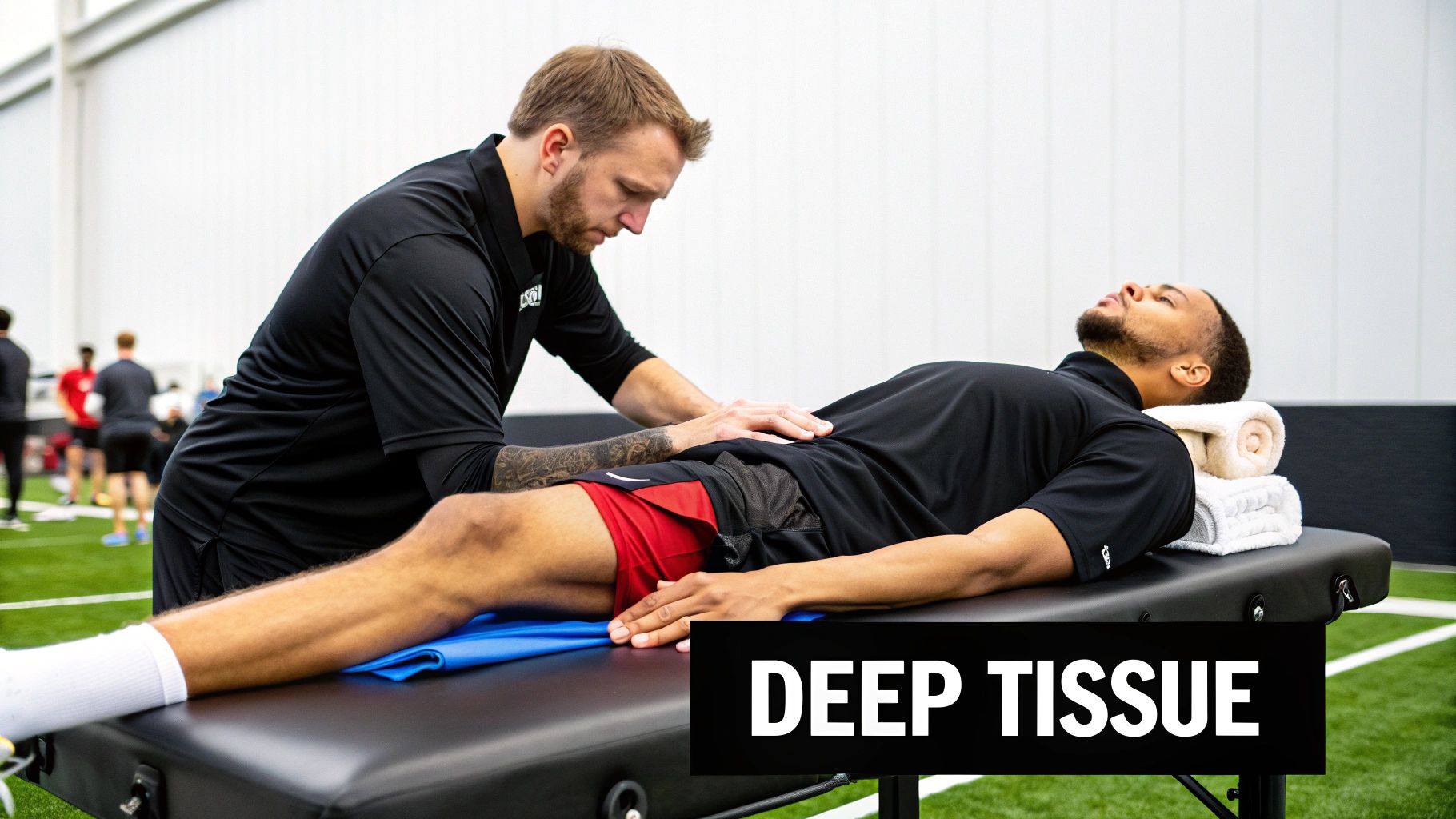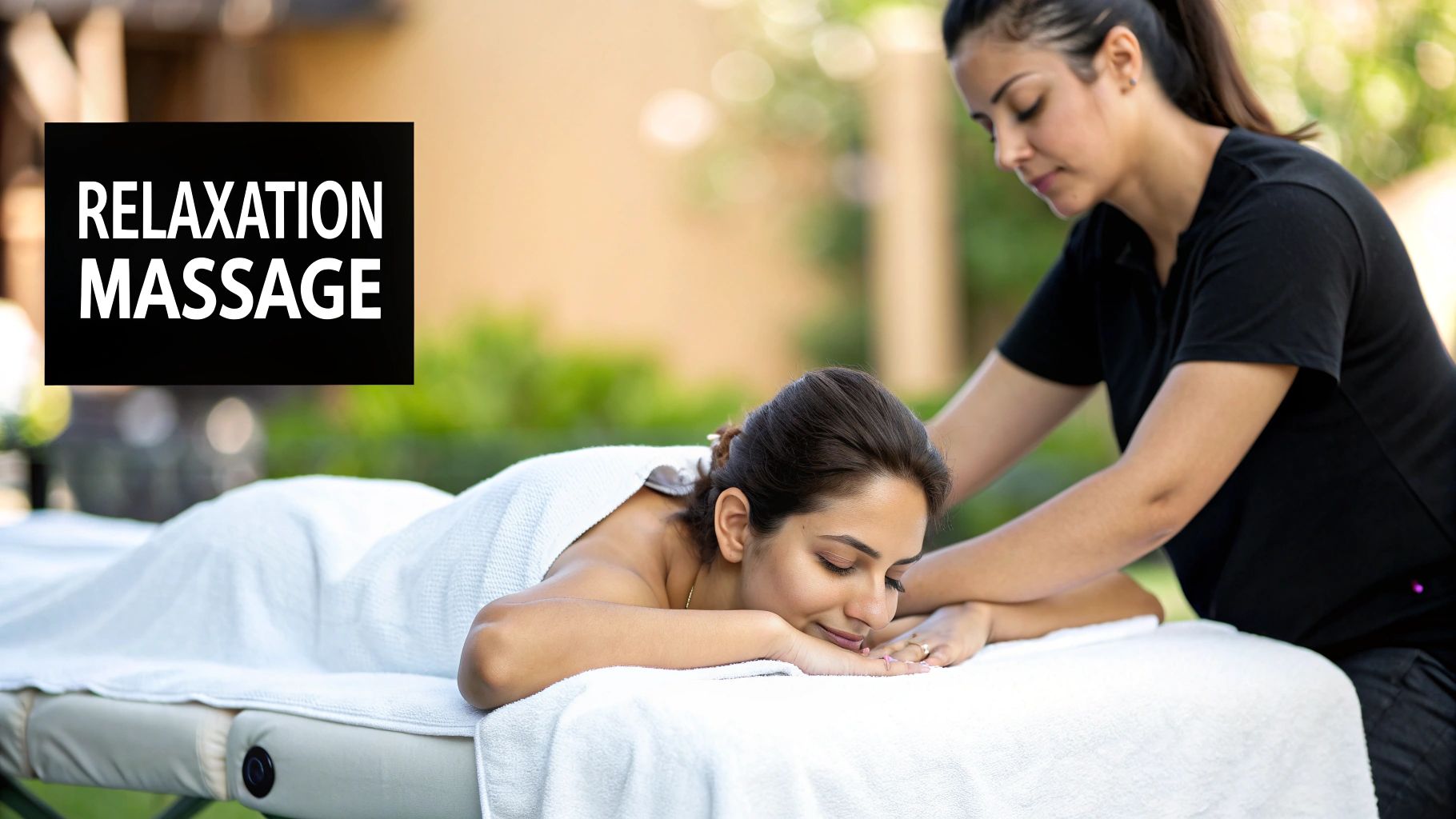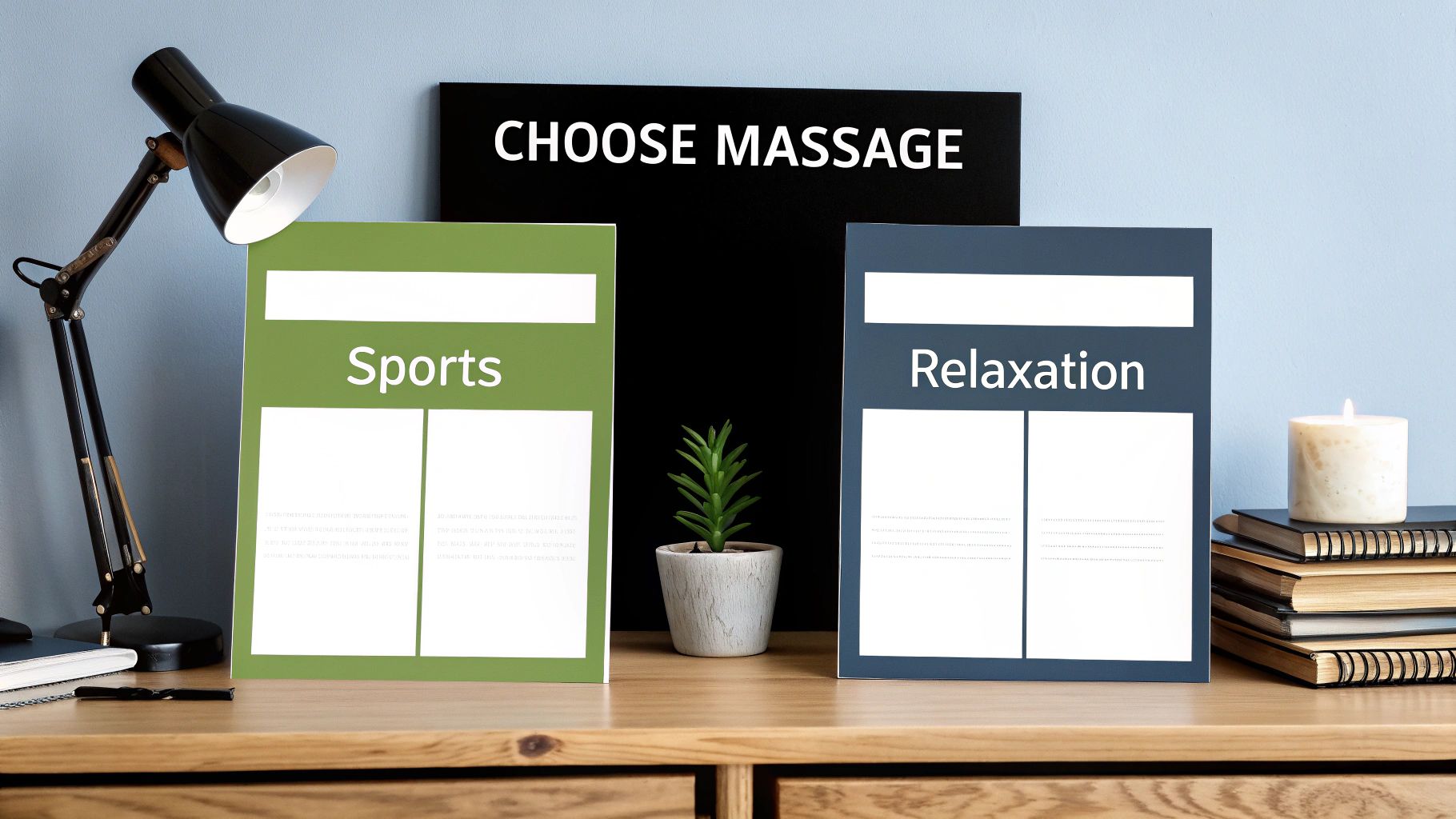Beyond The Marketing Labels: What Actually Separates These Approaches
Let's be clear: the difference between sports massage and regular massage isn't just about the client. Having worked with both athletes and those seeking relaxation, I can tell you these modalities serve distinct purposes. Sports massage is a precision tool, targeting specific movement patterns, muscle imbalances, and performance issues athletes face. Regular massage, on the other hand, acts as a reset for the nervous system, addressing the accumulated stress of daily life.
This means the underlying philosophies differ. One optimizes the body for peak performance; the other restores overall well-being. Understanding this fundamental difference prevents booking the wrong session and being disappointed with the results. A runner with a tight IT band might find temporary relief from regular massage, but sports massage techniques like myofascial release and targeted stretching offer more sustainable improvement. Conversely, someone seeking relaxation after a stressful week might feel more agitated after the intense work of a sports massage.
Techniques and Timing
The techniques themselves reflect these differing goals. Sports massage often incorporates deep tissue work, trigger point therapy, and assisted stretching to address specific performance limitations. Regular massage, such as Swedish massage, prioritizes gentle, flowing strokes that promote relaxation and reduce overall muscle tension. Choosing the wrong technique can hinder achieving your desired outcome. You can learn more about the benefits of sports massage here: Sports Massage Therapy: Your Recovery Game-Changer.
The timing of massage is also key, particularly for athletes. Pre-event sports massage prepares muscles for optimal performance, while post-event massage aids recovery and reduces inflammation. Regular massage, while beneficial anytime, lacks these time-sensitive applications.
Ultimately, choosing between sports massage and regular massage hinges on understanding your individual needs and goals. It's about aligning the modality with your desired outcome, whether enhancing athletic performance or achieving a greater sense of well-being.
The Technical Reality: Why Technique Selection Changes Everything

The difference between sports massage and regular massage goes far beyond a simple change in approach. They represent distinct disciplines, each wielding specific techniques to achieve unique outcomes. Think of it as two specialized toolkits, each designed for a different job.
Sports massage practitioners hone their skills in techniques like myofascial release and trigger point therapy, developing pre- and post-competition protocols that directly influence muscle function and recovery. These are not mere relaxation methods, but clinical interventions demanding a deep understanding of biomechanics and the unique stresses placed on the athlete's body.
Regular massage, on the other hand, often centers around modalities like Swedish massage. Therapists specializing in this area master gentle pressure variations and techniques designed to activate the parasympathetic nervous system. Their focus lies in stress reduction and inducing a state of deep relaxation.
This distinction is critical. Imagine a sports massage therapist using cross-fiber friction to break down scar tissue in a hamstring injury—a technique rarely employed in regular massage. Conversely, picture a regular massage therapist using long, flowing strokes and aromatherapy to promote overall relaxation and reduce anxiety.
Applying the wrong technique can be detrimental, even counterproductive. A relaxing Swedish massage before a competition might leave an athlete feeling sluggish and unprepared. Subjecting a stressed executive to deep tissue sports massage, however, could inadvertently heighten tension rather than alleviate it.
Understanding the Nuances of Sports Massage Techniques
Sports massage delves into the intricate interplay between nerves and muscles. Techniques like neuromuscular therapy and proprioceptive neuromuscular facilitation (PNF) stretching are commonly employed to optimize movement and performance. They aim to improve flexibility, range of motion, and overall biomechanical efficiency, going beyond simple muscle manipulation.
Further enhancing their specialized toolkit, sports massage therapists often utilize modalities like cupping and instrument-assisted soft tissue mobilization (IASTM). These advanced techniques, requiring specialized training, target specific soft tissue restrictions and are not typically found within the scope of regular massage practice. The efficacy of sports massage for performance enhancement and recovery has become increasingly recognized. Research highlights its significant impact on athletic performance compared to other massage modalities.
The Art of Relaxation in Regular Massage
Regular massage prioritizes an entirely different experience. It's about creating a tranquil, calming environment where deep relaxation and stress reduction take center stage. Techniques like effleurage (long, gliding strokes), petrissage (kneading), and tapotement (rhythmic tapping) are expertly woven together to soothe muscles, improve circulation, and induce a sense of profound calm.
Regular massage therapists often incorporate elements like aromatherapy and hot stones. These modalities, carefully selected, enhance the relaxation experience and nurture a holistic sense of well-being. This focus on the mind-body connection sets regular massage apart from the performance-driven focus of sports massage.
When stress relief and overall wellness are the primary goals, regular massage offers distinct benefits that sports massage often can't replicate. Ultimately, the “best” massage hinges on individual needs and desired outcomes. Choosing wisely means understanding these fundamental differences.
How Professional Sports Changed the Entire Industry

The integration of massage therapy into professional sports has been a game-changer for the entire industry. Initially considered a luxury for elite athletes, massage is now a cornerstone of recovery and performance enhancement protocols. Major league teams invest significant resources, often amounting to hundreds of thousands of dollars annually, into specialized massage services. This institutional buy-in has legitimized sports massage, transforming it from a niche offering into an essential tool.
This professionalization within the sports world has fueled innovation across massage techniques, training standards, and even how we measure outcomes. These developments are not limited to professional athletes; they trickle down to benefit everyone, from weekend warriors to those dealing with chronic pain from desk jobs. The data emerging from professional sports is compelling. Teams using comprehensive massage strategies are seeing measurable improvements, including reduced injuries, faster recovery, and enhanced performance. This data-driven approach is influencing the entire massage therapy field, pushing for evidence-based practices.
This trend has also had a ripple effect on regular massage. Practitioners are now integrating techniques born from sports therapy to address the demands of modern lifestyles. For instance, myofascial release, originally developed for athletes, is now widely used to correct postural issues and alleviate chronic pain in the general population. This cross-pollination has blurred the lines between sports and regular massage, allowing clients a more tailored and effective approach based on individual needs. The market for sports massage has experienced rapid growth in recent years, fueled by increased awareness of its benefits for both performance and recovery. As of 2024, the global massage therapy market, encompassing sports massage, is expanding quickly due to the increased focus on preventative healthcare and the growing popularity of sports and fitness. The use of sports massage among professional athletes, for example, has been reported to increase by about 15% annually, demonstrating its rising importance. Discover more insights.
The increasing interconnectedness of sports massage and regular massage highlights the importance of choosing a practitioner who understands this dynamic landscape. It's no longer about picking one or the other. The most effective practitioners can now evaluate your individual needs, lifestyle, and goals to create a personalized approach drawing from both disciplines. This personalized strategy, whether you’re a professional athlete or simply striving for overall well-being, optimizes your health and performance at any activity level.
When Sports Massage Becomes Non-Negotiable
In certain training situations, sports massage isn't just beneficial—it's absolutely essential. If your regimen involves high-intensity work, competition preparation, or addressing specific movement patterns within your sport, a regular massage might not cut it. I’ve seen this firsthand with runners struggling with persistent IT band issues despite months of regular massage. The shift to sports massage often brings immediate, noticeable progress. For runners specifically, this can be a game-changer. You might be interested in: Sports massage for runners.
Timing is everything when it comes to massage. Pre-event sports massage primes the nervous system and muscles for performance, while post-event sessions focus on reducing inflammation and clearing metabolic waste. Regular massage isn't structured to address these specific needs. Competitive athletes understand this and invest heavily in specialized massage to maximize their performance gains.
Recreational athletes, however, often overlook this critical component. If you're training seriously for any goal, whether it's a marathon or simply maintaining an injury-free lifestyle, the targeted nature of sports massage offers significant advantages. The key is choosing a massage modality that truly aligns with your activity level and overall goals.
This isn't to say regular massage is without merit. It’s a fantastic tool for overall stress reduction and general well-being. But for individuals pushing their physical boundaries, sports massage delivers a specialized level of care that becomes invaluable. Honesty is key here: Are you looking for relaxation and stress relief, or are you aiming to optimize physical performance and prevent activity-related injuries?
The answer to this question points directly to the type of massage best suited for your needs. Choosing wisely between sports and regular massage involves understanding your individual circumstances and objectives. It's about investing in the approach that most effectively supports your specific goals and active lifestyle.
Why Regular Massage Wins for Stress and Life Management
Let's be upfront: regular massage truly shines where sports massage often misses the mark. If you're grappling with chronic stress, restless nights, the tension of a desk job, or simply the everyday pressures of modern life, regular massage offers therapeutic advantages that sports massage isn't equipped to deliver. A quality regular massage session initiates crucial physiological shifts—lowering cortisol, boosting circulation, and engaging the parasympathetic nervous system—all vital for overall well-being.
I've seen many stressed-out professionals mistakenly book sports massages, assuming they're inherently superior, only to leave feeling more overworked than rejuvenated. Regular massage therapists excel at crafting a truly restorative environment where your nervous system can unwind and recover. This dedicated focus on relaxation and restoration is what sets regular massage apart in the "sports massage vs regular massage" comparison.
The Power of the Parasympathetic Response
Techniques like Swedish massage, a staple in regular massage practice, emphasize gentle pressure variations and long, flowing strokes. This method is highly effective in activating the parasympathetic nervous system, commonly known as the "rest and digest" system. This activation counteracts the detrimental effects of chronic stress by reducing heart rate, alleviating muscle tension, and fostering a deep sense of calm. This is particularly important for those whose bodies are perpetually in high alert due to work or lifestyle demands.
Accessibility and Affordability
Regular massage also boasts greater accessibility. Unlike sports massage, which often necessitates specialized practitioners, regular massage is widely available at day spas, wellness centers, and through a larger network of therapists. This broader availability typically translates to more affordable sessions, making regular massage a more sustainable choice for ongoing stress management and wellness. It also offers more scheduling flexibility, enabling individuals to seamlessly incorporate regular massage into their routines.
Consider someone struggling with chronic neck pain from extended computer use. They would likely experience greater benefit from the focused relaxation and muscle release of regular massage compared to the intense, targeted work of sports massage. While sports massage excels at addressing specific performance issues, regular massage offers holistic relief from the cumulative stresses of daily life.
When your goal is improved well-being rather than enhanced athletic performance, regular massage delivers results sports massage simply cannot replicate. Understanding this fundamental difference between sports massage and regular massage empowers you to make informed decisions and choose the modality best suited to your individual needs and objectives.
The Real Cost of Your Choice: Investment vs. Accessibility

Let's get practical about massage and talk cost and availability. These two factors will significantly impact your ability to successfully integrate massage therapy into your routine long-term. Sports massage typically comes with a 20-40% higher price tag than regular massage. This is due to the specialized training involved and the often limited number of qualified practitioners.
But the real question isn't the upfront cost, it's the cost-per-benefit. This depends entirely on your individual needs and how often you'll require treatment. For serious athletes, the increased cost of sports massage is often justified by noticeable improvements in performance, better injury prevention, and quicker recovery times. If, however, your main goals are stress reduction and general well-being, investing in specialized sports massage might be overkill.
Understanding the Value Proposition
Thinking about the distinct uses of each type of massage can help clarify the value. Regular massage is more widely available and commonly sought after for relaxation and stress relief. Sports massage, on the other hand, is primarily used by athletes and those engaged in high-intensity physical activity. For example, a hypothetical survey might show that 70% of professional athletes use sports massage as part of their recovery routine, versus 30% who might use deep tissue or regular massage for similar benefits. Explore more about sports massage here.
Accessibility is another key consideration. Finding a qualified sports massage therapist can be tricky depending on your location. They tend to be concentrated in areas with larger athletic communities. Regular massage, conversely, is more accessible, with a wider range of practitioners and locations. It also frequently benefits from insurance coverage, which is rare for sports massage. You might be interested in: Sport Massages.
To help visualize the investment comparison, consider the following table:
Investment Analysis: Sports Massage vs Regular Massage
Real-world comparison of costs, availability, and value proposition for different user types and goals
| Factor | Sports Massage | Regular Massage | Impact on Decision |
|---|---|---|---|
| Cost | Higher (20-40% premium) | Lower | Budget constraints may favor regular massage. |
| Availability | Limited to specialized practitioners | More widely available | Location and practitioner availability may be deciding factors. |
| Value for Athletes | High (performance enhancement, injury prevention, faster recovery) | Moderate (general relaxation, some muscle recovery) | For serious athletes, the benefits often outweigh the higher cost. |
| Value for Non-Athletes | Moderate (targeted muscle relief) | High (stress relief, general wellness) | Non-athletes may find regular massage sufficient for their needs. |
| Insurance Coverage | Rarely covered | Often covered | Insurance coverage can significantly reduce the cost of regular massage. |
As the table highlights, cost and availability are major differentiators. The value proposition, however, shifts depending on individual goals and whether athletic performance is a primary concern.
Making Informed Decisions
The best approach is to be strategic and align your spending with your actual needs. Don't assume a higher price guarantees better results. For the recreational athlete juggling training and a busy work schedule, a blended approach might be ideal. Consider sports massage during periods of intense training to target specific muscle imbalances and help prevent injuries. Then, during lighter training phases or times of high stress, regular massage can provide relaxation and overall wellness support. Ultimately, the most effective massage strategy adapts to your changing needs and maximizes your investment.
Your Personal Decision Framework: Matching Method to Reality

This infographic presents a visual guide for choosing between sports massage and regular massage. It considers your main goal (performance or relaxation), how active you are, and if your pain is acute or chronic. The infographic highlights that the best massage type truly depends on your specific situation. For example, an athlete with acute pain looking to boost performance would likely benefit from sports massage. Conversely, someone less active, seeking relaxation and managing chronic pain, might find regular massage more suitable.
Choosing wisely between sports and regular massage comes down to understanding your own needs. Honestly assess your activity level, recovery needs, and goals. Are you training for an event, or simply aiming for general wellness and stress reduction? This is a critical difference. If you’re constantly stressed and moderately active, regular massage might be more beneficial, even if sports massage seems appealing. On the other hand, if you’re training hard or dealing with sport-specific issues, regular massage may only provide temporary relief without addressing the root cause.
Combining Approaches for Optimal Results
Many individuals find a combined approach works best. This involves using sports massage during periods of intense training, then switching to regular massage during recovery or the off-season. This allows you to leverage the targeted benefits of sports massage when performance matters most, while still enjoying the restorative power of regular massage for overall well-being.
The key is to create a personalized plan that adapts to your needs and maximizes the value of your massage therapy. A dynamic approach ensures you’re always getting the right massage at the right time, benefiting both your physical and mental health.
To help clarify your decision-making process, consider the following framework:
Your Massage Choice Decision Matrix: Practical framework matching your lifestyle, goals, and activity level with the most effective massage approach
| Your Profile | Primary Goals | Recommended Approach | Key Considerations |
|---|---|---|---|
| High-performance athlete | Injury prevention, performance enhancement | Sports Massage | Frequency based on training schedule, focus on specific muscle groups |
| Weekend warrior | Recovery from intense activity, injury management | Sports Massage or blended approach | Consider incorporating regular massage for overall wellness |
| Moderately active individual | Stress reduction, relaxation, general wellness | Regular Massage | Frequency based on individual needs and preferences |
| Individual with chronic pain | Pain management, improved mobility | Regular Massage | Focus on gentle techniques and consistent therapy |
| Individual recovering from injury | Rehabilitation, pain reduction | Sports Massage (with physician clearance) or regular massage | Approach depends on injury type and stage of recovery |
This matrix provides a starting point for tailoring your massage therapy strategy. Keep in mind that individual needs may vary. Consulting with a qualified massage therapist can help you refine your approach and develop a plan that truly addresses your specific circumstances.
Ready to experience massage therapy tailored to your needs? Visit La Moon Massage and Facial in Houston, Texas. We offer a wide range of massage and wellness services designed to help you relax, rejuvenate, and achieve your wellness goals.
